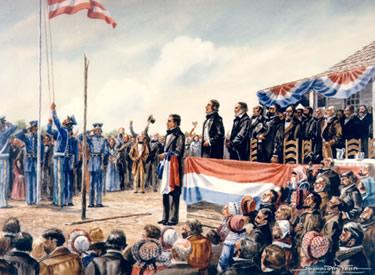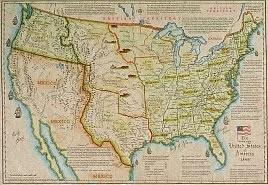
The Annexation of Texas to the Union, painting by Donald M. Yena.
February 19, 2020 - When Texans rose in armed revolt against Mexico, they did so with the sympathy and support of the people, if not the government of the United States. Texans were kinfolk; and the people of the nation east of the Sabine River sent them men, money and munitions. The Twin Sisters which constituted Sam Houston’s artillery at the battle of San Jacinto were a gift of the ladies of Cincinnati; the New Orleans Grays mingled their blood with that of the colonists in the slaughters of San Jacinto and Goliad. The government itself was not unfriendly on the unofficial side.
Had not John Quincy Adams done his best to buy Texas? Wasn’t the one move nearest and dearest to the heart of Andrew Jackson the acquisition of Texas?
As a consequence of these things, Texans naturally supposed that they would be welcomed into the Union of States, and the Constitutional Convention at Washington-on-the-Brazos adopted a resolution, to be later submitted too the people calling for annexation. This resolution was submitted to the people in November 1836 and it carried by a large margin.
In the meantime, the cause of Texas suffered. When the victory at San Jacinto was announced in the United States, there was a great cry for immediate recognition of the new republic. Congress was inundated by the appeals. Finally, to still the popular clamor, Henry Clay brought to the Senate from the Foreign Relations Committee a namby-pamby resolution to recognize Texas when and if it was determined that Texas had achieved a de facto government; in other words, if Texas could maintain herself independent, the United States would, at its’ leisure, investigate this status and if Texas was found to be independent, then recognition would be granted.
The South was hot for recognition and annexation; the North and East opposed. Recognition, when it came, was a political trick. In the final session of Congress, during a late night session, with many absent, the Senate passed a resolution for recognition; and in the House an amendment was offered to an appropriation bill to cover the expenses of a representative to the Republic of Texas. In the face of such an attitude, there is small wonder that Texas withdrew its offer.
In 1842, Sam Houston was inaugurated for his second term as president of the Republic. In his inaugural address, he extolled England and warned Texans not to expect help from the United States. He was however, beginning a series of diplomatic negotiations based on a foreign policy which was to be, as he wrote to his Secretary of State, Anson Jones, “as sharp-sighted as lynxes and as wary as foxes.” It was. Houston played both ends against the middle. Either Texas was to become a part of the United States, or it would have sufficient support from abroad to stand alone. He was not even frank with his old friend and patron, Andrew Jackson. Indeed, he played Jackson’s known hatred for England to the utmost. This roused Andrew Jackson and the South to the danger of an English foothold in the Southwest.
Meanwhile, John Tyler had become president. He was, for all practical purposes, a president without a party – he had angered his own party and was without support of the other. With nothing to lose, he came out strong for the annexation of Texas; apparently it was a personal desire to accomplish something brilliant for his country and win himself a place in history. This encouraged the Texans. Tyler continued to negotiate, and in 1844, a treaty of annexation was secretly signed. Texas was to come into the Union as a territory. As soon as the existence of the treaty was suspected, the United States was in an uproar. Being an election year, the smart politicians of the Senate smelled danger. The country was doing well, and in the long run, it gained by the rejection. But rejection threw Texas squarely in the middle of the presidential campaign. Texas was the burning question of the campaign and at the Democratic Convention the party split over the issue. In the end, Jackson’s influence carried the day. He devoted all his energies to writing letters in support of Polk and Texas.
 Polk was elected by a narrow margin, and before he was inaugurated, Congress passed a resolution for the annexation of Texas. It was signed, as was fitting, by John Tyler on February 27, 1845. The Republic entered the United States as a full-fledged state; it retained title to its public lands; it retained the right to divide itself into five states if it wished. On December 29, 1845, the Congress formally voted to admit Texas into the Union and on February 19, 1846, President Anson Jones lowered the lone star flag at the capitol in Austin and muttered these words, “The Republic of Texas is no more.”
Polk was elected by a narrow margin, and before he was inaugurated, Congress passed a resolution for the annexation of Texas. It was signed, as was fitting, by John Tyler on February 27, 1845. The Republic entered the United States as a full-fledged state; it retained title to its public lands; it retained the right to divide itself into five states if it wished. On December 29, 1845, the Congress formally voted to admit Texas into the Union and on February 19, 1846, President Anson Jones lowered the lone star flag at the capitol in Austin and muttered these words, “The Republic of Texas is no more.”









